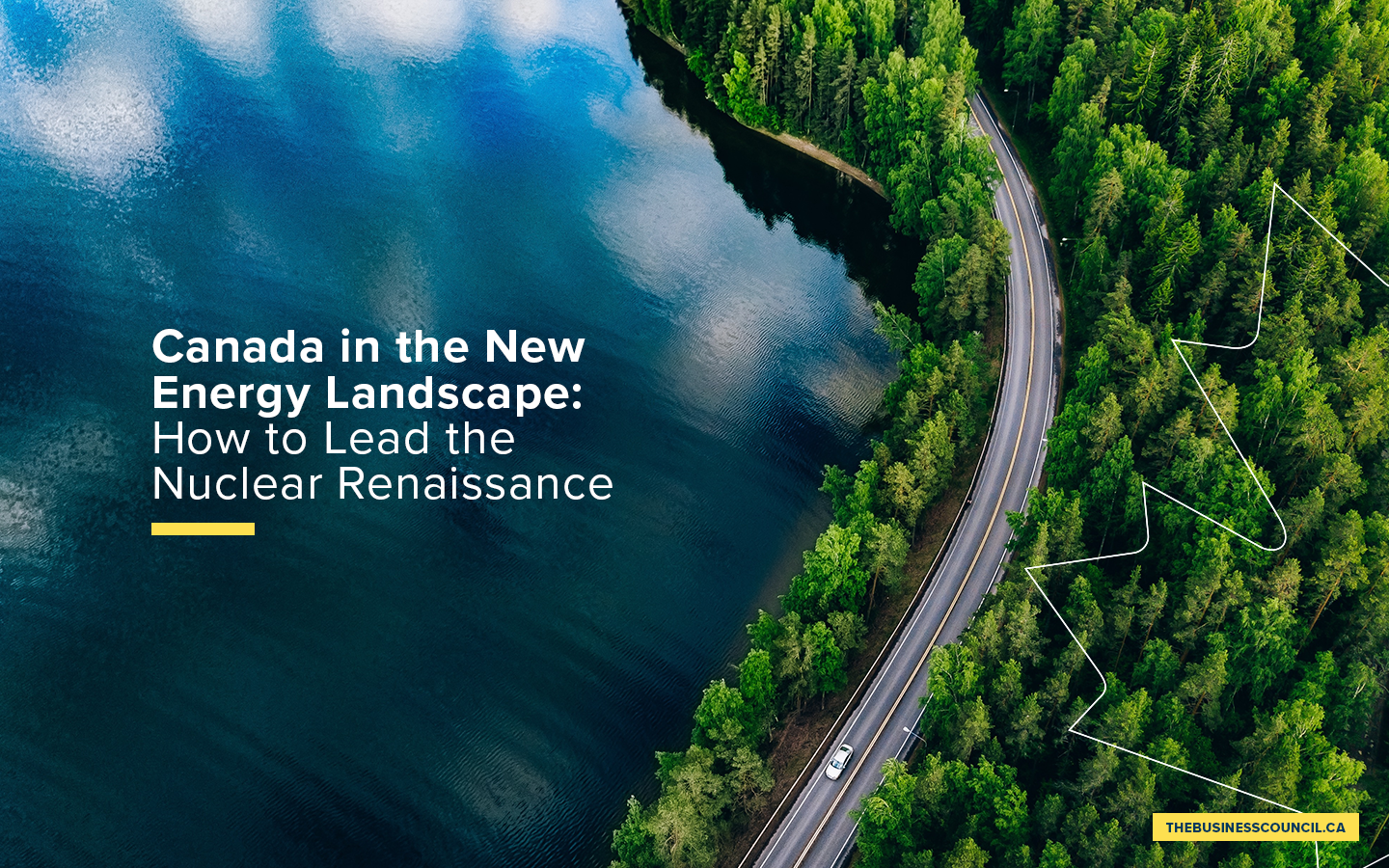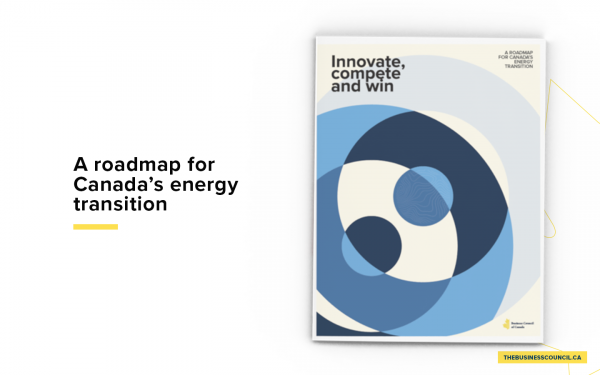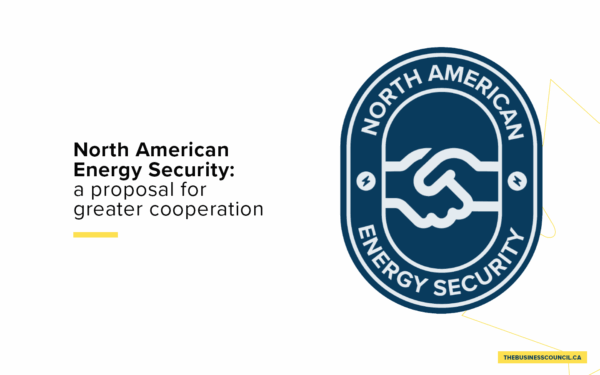Canada in the New Energy Landscape
How to Lead the Nuclear Renaissance
Introduction
Political and public policy discourse in Canada is seized with debates on various approaches to the transition away from burning fossil fuels towards alternative sources of energy. There are different views on the timeline of doing so, and how to balance reliability, affordability and sustainability as we adapt our energy systems.
Yet whether it is reducing emissions by 2030 or reaching net zero by 2050, nuclear power will need to play a bigger role in the Canadian and global energy mix of the future. Uniquely, it provides non-emitting baseload power, can be located almost anywhere, is able to generate industrial heat, and is incredibly energy dense with low resource and land requirements. This is very good news for Canada, a country that is poised to capitalize on the global renaissance in nuclear energy, both as a producer and as a consumer.
Canada has world-class deposits of high grade uranium; is home to a globally significant provider of uranium fuel in Saskatchewan-based Cameco; enjoys a comprehensive domestic nuclear supply chain; is already the sixth largest producer of nuclear power in the world; and is one of a handful of countries with intellectual property in nuclear reactor technology, through its CANDU design. Emerging third (Gen III+) and fourth (Gen IV) generation nuclear technologies have additional promise for Canada’s geography and economic base, promising low carbon, off grid heat and power for remote communities, mines, oilsands, and energy intensive industries such as petrochemicals and fertilizers.
In addition to these practical considerations, Canada has two intangible advantages. One is that nuclear power currently has support from the federal government (Liberals) and the opposition (Conservatives), several provincial governments (in particular Ontario, New Brunswick, Saskatchewan and Alberta), and a majority of Canadians – 57 per cent according to a January 2023 poll by Angus Reid. Notably, that support is at 70 per cent in Ontario, where the majority of Canadian nuclear power is produced. In a fast-moving and growing sector, this is a huge advantage, as other would-be competitors in Europe and Australia continue to debate the merits of nuclear.
The second advantage is that Canada is a trusted supplier of uranium fuel and nuclear technology, with a highly respected, independent and quasi-judicial nuclear regulator. While agreements with nuclear leaders and geopolitical superpowers Russia, China and even the United States may have political overtones, Canada is generally seen as a reliable, trustworthy and more neutral supplier. That can translate into a competitive advantage for Canada as well as enhanced energy security for its allies.
The Business Council of Canada supports the further development of Canada’s nuclear supply chain and encourages policymakers to work with the private sector to maximize opportunities and competitiveness in the global nuclear industry. This report explores some of the trends in nuclear energy that Canada could take advantage of with the right combination of policy, ambition and investment.
The nuclear renaissance
Nuclear energy is a very important source of power, representing 10 per cent of global electricity production, and almost 20 per cent of that produced in advanced economies. It experienced strong growth in the 1970s and 1980s as a response to a succession of energy crises resulting from oil price spikes in 1973 and 1979. However, the incidents at Three Mile Island in 1979 and Chernobyl in 1986 provoked anti-nuclear movements, increased regulatory burdens, and dampened public interest in nuclear energy. The Fukushima incident in 2011 spurred further phaseouts of nuclear energy, especially in Germany and Japan, although the latter has since reversed course. Nuclear power capacity started to plateau in North America and western Europe around 1990, although growth continued in Asia, particularly in China.
Three drivers have led to changing fortunes for nuclear energy in the past few years, leading to what’s often described as a nuclear “renaissance”: energy transition, energy security and technology.
1. Energy transition
As nations and utilities seek to diversify away from greenhouse gas (GHG)-emitting coal and natural gas for power generation, major alternatives that have emerged include hydroelectricity, wind, solar and nuclear. The advantages of nuclear power have been on full display: it boasts the lowest GHG emissions of all energy technologies, 24/7 availability, operational flexibility, a small land footprint and the ability to decarbonize hard-to-abate activities such as cement and petrochemical production.
Its climate benefits were on full display in Ontario’s successful coal phase-out program in the early 2000s, which stands out as one of the world’s largest and most successful GHG and pollution reduction policies. To achieve its clean energy transformation, Ontario added 35 TWh of low GHG-emitting sources of generation to its supply mix; 91 per cent of that new energy supply was derived from nuclear power generation. As Canada and the world transition to a cleaner electricity grid, nuclear energy is set to play a leading role.
2. Energy security
The security aspects of nuclear energy took on additional significance in the wake of Russia’s invasion of Ukraine in February 2022. Europe, imposing sanctions on Russian pipeline gas, has desperately sought alternatives, and spikes in prices for LNG globally have made nuclear energy appear more cost competitive, less volatile, and less reliant on authoritarian regimes.
Whereas renewable energy depends heavily on goods manufactured in China and critical minerals sourced from unstable or authoritarian countries, and global oil supply depends to a large extent on OPEC+, the nuclear energy supply chain can be sourced from western and democratic countries and allies. In Canada, the nuclear supply chain is almost wholly domestic.
Some allies continue to depend on Russian enriched uranium, a market in which that nation leads. This has spurred the United States to pass bipartisan legislation to enhance the security of its nuclear fuel supply, and led to an alliance between the U.S.A, Japan, United Kingdom, France and Canada to collectively enhance nuclear fuel security, announced on the sidelines of the G7 in Sapporo, Japan in April 2023.
3. Technology
The main objections to nuclear energy have been that they pose unnecessary safety risks and that they are too expensive. These statements have been negated by decades of safe performance with jurisdictions using nuclear energy having stable, affordable electricity prices. The latest generation of nuclear technology – known as Gen IV designs – is further revolutionizing nuclear technology to address these concerns. Central to this latest wave are SMRs: small, modular reactors. While larger reactors will remain the preferred option for many situations, especially where power density is required for the electrification of cities and major industries, SMRs introduce greater flexibility to the nuclear energy mix.
According to the International Atomic Energy Association, small modular reactors (SMRs) are advanced nuclear reactors that have a power capacity of up to 300 MW(e) per unit, which is about one-third of the generating capacity of traditional nuclear power reactors. SMRs are: (1) small – physically a fraction of the size of a conventional nuclear power reactor (2) modular – making it possible for systems and components to be factory-assembled and transported as a unit to a location for installation; and (3) reactors – harnessing nuclear fission to generate heat to produce energy.
Due to these features, advanced SMRs are anticipated to be cheaper to build than traditional reactors. Modularity allows reactors to be prefabricated and then assembled on site, saving in construction time and costs. A sub-category of SMRs, the microreactor, is generally less than 20MW(e), and small enough that it can be safely transported as a plug-and-play unit on a truck, train or cargo plane.
As smaller units, SMRs require less footprint than traditional reactors, making them more flexible in siting. Because most SMRs are not water cooled, they can also be placed in locations without a significant water source. This can reduce the time and money associated with transmission build and opens up reliable energy options in rural and remote areas. In addition, they are often meant to be scalable, with multiple units co-located depending on specific MW needs. This includes the four GE Hitachi BWRX-300 MW reactors planned for Darlington in Ontario, or the twelve Xe-100 80MW reactors planned in central Washington state.
Gen III+ and Gen IV models are also being designed using passive and inherent safety features, requiring no human intervention to shut down. This dramatically limits and even eliminates the potential for serious incidents such as meltdowns. In addition, some models can go years, or even a decade, without being refuelled.
New nuclear technologies are also opening up advanced energy uses. While traditional reactors were almost always developed to produce grid-scale power, emerging reactor models are being developed for industrial decarbonization. Many industries require process heat at levels between 100-1500°C, for example in manufacturing chemicals, cement, steel and other metallurgical processes. Fossil fuels are excellent at generating high temperatures for process heat and are hard to replace through electrification. However, the highest-temperature Gen IV reactors, known as very-high-temperature reactors (VHTR), can generate a temperature in the order of 1000°C, making them useful for a number of industrial applications. New reactor models can also be optimized for creating hydrogen or for desalination, two energy-intense applications which are expected to become increasingly important to support future low carbon energy and clean water supply needs, respectively.
Advanced reactors thus provide not only the reliability and low carbon characteristics appreciated from the current nuclear reactor fleet, but promising new applications that will help guide the future of energy for both community and economic development.
Canada’s nuclear pedigree
At the heart of nuclear fission is uranium, a metal with the highest atomic weight (92) of any naturally occurring element. In the Athabasca Basin of northern Saskatchewan lies the world’s richest uranium deposits. While many of the world’s largest mines have uranium ore grades in and around 0.10 per cent, some deposits in Saskatchewan are up to 20 per cent average grade. Cigar Lake, the world’s highest grade and largest producing uranium mine, has an average grade of 17.21 per cent U3O8, the compound created when uranium ore has been mined and milled.
Saskatchewan uranium fuelled American and British nuclear programs in the Cold War, and then supplied the first CANDU reactors. Canadian Nuclear Laboratories (CNL) in Chalk River, Ontario, has been designing, building and experimenting with nuclear reactors since the Second World War.
CANDU, short for Canada Deuterium Uranium, is a nuclear reactor that uses heavy water as a moderator and coolant and natural uranium as a fuel source. The development of the first CANDU reactor began in 1954 through a partnership between Atomic Energy of Canada Ltd., Ontario Hydro and the Canadian General Electric Company, and the first full scale generating station commenced operations in 1968 in Ontario. Canada has produced 47 CANDU nuclear reactors, with 34 of those operating internationally. Domestically, CANDU reactors were built in Ontario, Quebec and New Brunswick. Quebec’s Gentilly nuclear power station was decommissioned in 2012. Ontario continues to have three nuclear plants – Bruce, Pickering and Darlington – and New Brunswick has a plant in Point Lepreau. Nuclear power produces 15 per cent of Canada’s electricity and 60 per cent of Ontario’s electricity. Canada’s 81 TWh of nuclear production in 2022 made it the world’s sixth largest nuclear power producer.
Current advances in CANDU nuclear energy
There was no further construction of CANDU reactors in Canada following the completion of Darlington 4 in 1993, due to a drop in electricity demand and concerns about predictability of construction costs. However, the CANDU supply chain has remained active, and is witnessing its own revitalization. Major refurbishments are ongoing at both the Darlington and Bruce power plants, and so far have come in ahead of schedule and on budget. The refurbishment program has also injected about $30 billion into the Canadian nuclear supply chain, a robust network of over 250 supply chain companies and suppliers. With 90 per cent of Bruce Power’s and OPG’s spend on the project in Ontario and 98 per cent in Canada, the refurbishment program is truly a Canadian infrastructure project.
That active supply chain will help support the next wave of nuclear power in Canada. Not only is Bruce Power proposing to build Canada’s first new large scale nuclear site in three decades, but the country is also preparing to see OPG construct the country’s first four SMRs at the Darlington site.
CANDU technology continues to progress and its defining features – the unique ability to use unenriched uranium and other fuels, on-power refuelling, and a number of active and passive safety features – remain very attractive. Romania is building two new CANDU-6 reactors at its Cernavodā nuclear power plant. In September 2023, Natural Resources Canada announced $3 billion in export financing to support the project, which will flow to Canada’s nuclear supply chain.
The CANDU Owner’s Group, which includes CANDU operators from Ontario, New Brunswick, China, South Korea, India, Argentina and Romania, continues to collaborate to pool resources for innovative research, development and joint projects. They have invested hundreds of millions of dollars in research and development to advance CANDU technology, much of which involves process innovation: improving the efficiency, economics, safety, and performance of CANDU reactors.
CANDU reactors are also able to produce nuclear isotopes that are then used to sterilize medical devices, in medical imaging and diagnostic procedures, and in medicine and new drug development. Ontario’s CANDU reactors produce 50% of the global supply of Cobalt-60, and are developing production of molybdenum-99, helium-3, tritium and deuterium. This is unleashing growth and innovation in nuclear medicine, and positioning Canada at its centre. Beyond medicine, isotopes are also being used in neutron research, border security, food preservation, and quantum computing.
Current advances in Canadian SMR nuclear technology
The effort to realize the potential of SMRs in Canada has been concerted. As early as June 2017 CNL invited expressions of interest in SMRs. But political coordination began in earnest when Natural Resources Canada developed an SMR Road Map in 2018, followed by an SMR Action Plan in 2021, in close collaboration with Alberta, Saskatchewan, Ontario and New Brunswick, as well as Indigenous stakeholders, the private sector, crown corporations, research institutions and civil society. Those four provinces also put out their own interprovincial strategic plan for the deployment of SMRs in 2022, building on their provincial power utilities’ SMR feasibility study of March 2021. The Canadian Nuclear Safety Commission (CNSC) has been facilitating SMR developments through pre-licensing to identify fundamental barriers to licensing a new design in Canada and assure that a resolution path exists.
Nine models have been submitted to CNSC for pre-licensing: Terrestrial Energy’s Integral Molten Salt Reactor; Ultra Safe Nuclear Corporation’s MMR-5 and MMR-10 microreactors; ARC Nuclear’s liquid sodium ARC-100; Moltex’s stable salt reactor; SMR, LLC’s pressurized light water SMR-160; U-Battery’s high temperature gas U-Battery; GE Hitachi’s boiling water reactor BWRX-300; X-energy’s high temperature gas Xe-100; and Westinghouse’s eVinci microreactor.
A number of projects are advancing or planned in Canada. These include:
- The Darlington New Nuclear Project, which aims to deploy four GE-Hitachi BWRX-300, a 300 MW SMR, at OPG’s Darlington site in Ontario for on-grid power. The first is planned to be constructed by 2028, with commercial operation beginning in 2029.
- A 100 MW liquid sodium-cooled fast reactor, the ARC-100, at NB Power’s Point Lepreau site in New Brunswick, for on-grid power by 2030.
- Another ARC-100, at the Port of Belledune’s Green Energy Hub in New Brunswick, to produce clean hydrogen for export in collaboration with Cross River Infrastructure Partners in the mid-2030s.
- The GE-Hitachi BWRX-300 in Saskatchewan for potential deployment by SaskPower for on-grid power in the mid-2030s.
- The Ultra Safe Nuclear Corporation’s commercial demonstration project of its Micro Modular Reactor (MMR) at Chalk River Laboratories in Ontario, for operation by 2028.
Early and meaningful engagement and consultation with Indigenous peoples is ongoing for these projects. Indigenous peoples will be involved in the nuclear renaissance in three primary ways: (1) consultation on the nuclear regulatory process; (2) consent for siting of new nuclear reactors and waste storage on their territories; and (3) economic participation through equity ownership, construction, component manufacturing, workforce development, and other elements of the supply chain. One promising development was the announcement in September 2023 that the North Shore Mi’kmaq Tribal Council and its seven First Nations members are investing in the proponents of the SMR projects in New Brunswick, resulting in $2 million in share value from Moltex and $1 million in share value from ARC; a first of its kind agreement in the SMR sector.
While much of the attention on SMRs in Canada has been on forthcoming grid scale projects, a lot of the SMR potential for Canada is in industrial decarbonization, given the nature and geography of our economy. In addition to the Belledune project for hydrogen production, oilsands, mining, petrochemicals and fertilizers all offer compelling use cases. The Pathways Alliance of the six major oilsands companies are actively exploring SMRs as a means to reduce the emissions intensity of their barrels, using nuclear energy to produce steam for extraction of oil from Alberta’s northern oil sands deposits rather than using natural gas. Terrestrial Energy is headquartered in Oakville, Ontario but announced in March 2023 that it would open an office in Calgary to support commercial development of its model for industrial co-generation, and X-energy and Invest Alberta announced an MOU in January 2023 to develop economic opportunities supporting the deployment of its model. The Government of Alberta announced in September 2023 that it would contribute $7 million towards an SMR feasibility study being led by Cenovus, a large oil sands producer.
To the south, the Inflation Reduction Act has spurred new nuclear development projects with demonstration projects funded and being advanced by NuScale, X-energy, Holtec, and TerraPower. Dow, for example, has entered into a partnership with X-energy to build four Xe-100s at an industrial site at one of its Gulf Coast locations to decarbonize its chemical production. And Microsoft is implementing a global Small Modular Reactor (SMR) and microreactor energy strategy to power its energy-intense Artificial Intelligence business.
Remote mines in Canada are another logical use case. Energy costs are a huge deterrent for development in off-grid locations, and diesel is generally the only option, which poses its own logistical, economic and environmental challenges. One diamond mine in NWT uses up to 80 million litres of diesel a year. Leveraging SMRs to support remote mining operations promises to open up more deposits for development as global demand for critical minerals grows. The Government of Yukon commissioned an SMR feasibility study released in September 2023 that concluded that SMRs had a lower Levelized Cost of Electricity (LCOE) for off grid mines than comparable systems of diesel; wind and diesel; solar and diesel; wind and battery; solar and battery; hydro; and liquified natural gas.
Beyond the Arctic, a use case for very small, or nano, reactors exists as far afield as the moon. The Canadian Space Mining Corporation is developing a model for this very purpose. The sky is not the limit for nuclear development.
Nuclear waste
Concerns about waste are a common source of hesitancy to nuclear energy. The CNSC is responsible for the regulatory oversight of the management of radioactive waste, but the waste owners are responsible for its management, via the Nuclear Waste Management Organization (NWMO). The NWMO is implementing the Adaptive Waste Management approach that was selected by the Government of Canada for the long-term management of Canada’s used nuclear fuel, and will be constructing a deep geological repository in Ontario for that purpose. One element unique to the nuclear sector is that its operators have always, and continue, to both fully capture and pay for the long term costs of waste management as part of their ongoing production.
The NWMO plans to choose the final site in 2024, and has short-listed the areas of Wabigoon Lake Ojibway Nation-Ignace and Saugeen Ojibway Nation-South Bruce, based on their geology and willingness to host the depository. It is a significant economic undertaking in its own right: the cost of the multi-generational project is estimated at $26 billion (in 2020 dollars) over its approximately 175-year life cycle. The depository will be designed to account for the anticipated waste generated by SMR applications in Canada. The NWMO has developed an interim plan for transporting radioactive waste that considers regulatory requirements; potential vehicles (trucks vs rail); representative routes; nuclear security and escort arrangements; emergency management; logistics and scheduling of shipments; as well as operational aspects such as communication, monitoring and tracking of shipments.
Canada’s nuclear business opportunity
Nuclear has excellent applications that can provide the tailored, low carbon power and process heat that Canadian industry needs to compete and thrive. But in addition to the energy itself, there is a tremendous opportunity for Canada to become a major player in the global nuclear energy market. Canada has many inherent advantages: its high-quality uranium reserves, nuclear supply chain, nuclear fuel processing capacity, long record of safe nuclear power production, and large domestic market. It can leverage these to both grow CANDU’s global market share, and capture new market share as the emerging SMR sector reaches an estimated global market of $150 billion/year by 2040. It’s an exciting and dynamic time to be in the space as new private sector entrants to the nuclear industry, beyond large utilities and traditional vendors, bring fresh ideas and perspectives.
Three main opportunities stand out: expertise, supply chain and uranium fuel.
1. Nuclear expertise
Having engineering and operational expertise in both CANDU and SMRs is highly marketable. As a first mover in the advanced reactor space, Canada could develop a competitive advantage. Its nuclear regulator, the CNSC, is respected, flexible and politically independent, with high technical and scientific competence. Licenses approved under the Canadian regime lend credibility for other markets. That helps make Canada attractive for First-of-a-Kind, or FOAK, models. The Belledune hydrogen project, for example, will see NB Power accept higher costs associated with a FOAK, but position it to build local expertise and then capture consulting fees elsewhere.
Nuclear projects in Canada can also lock in research and intellectual property in critical areas of innovation such as engineering and construction methods, robotics, materials science, fuel testing and qualification, advanced manufacturing, control systems, cybersecurity, and remote operation.
2. Supply chain opportunities
The current Canadian nuclear industry, which is made up of 200+ suppliers, has developed around nuclear engineering, advanced manufacturing, and services, and primarily services CANDU heavy water reactors. As it expands into the SMR market, the creation of new facilities specialized in serial manufacturing and modularization will be needed. The SMR market is quite different, and much more reliant on serial manufacturing and modularization. The existing Canadian nuclear supply chain will need to grow to seize emerging opportunities. This will allow existing suppliers to expand, and for new entrants to enter the market. Main opportunities for the SMR supply chain include (1) technology vendors (2) system integrators (3) equipment manufacturers (4) sub-component suppliers and distributors (5) processors and fabricators and (6) raw material suppliers and miners (see figure 1).

Uranium fuel
As an energy dense, clean, reliable source of both power and heat with tremendous opportunities for technological advancement, nuclear energy is likely to grow in importance in the global energy mix. Just as oil and natural gas are highly strategic commodities today, nuclear fuel is likely to be so in the future, even more so than it is now.
By its nature, the market for nuclear fuel is much more concentrated than that of fossil fuels and has high barriers to entry, which bestows political and economic benefits to suppliers. The nuclear fuel fabrication industry is dominated by four companies serving international demand for light water reactors: Framatome and ORANO (France), Global Nuclear Fuel (United States, Japan), TVEL (Russia) and Westinghouse (United States). Canada does not enrich nuclear fuel, not least because its CANDU reactors use natural uranium.
Canada has a significant advantage to expand into nuclear fuel enrichment given that it is a very significant miner of uranium, the raw material for most nuclear fuels, and has decades of experience and a well-established international customer base for fuel services through Cameco. In addition, Westinghouse was acquired by a Canadian partnership between Brookfield Renewable and Cameco in 2022.
The development of large reactors like the Westinghouse AP1000 and new SMRs will change the landscape of nuclear fuel supply. Advanced reactors are being designed to require enriched fuel, including in some cases high-assay, low-enriched uranium, or HALEU, a product that currently only Russia supplies commercially. Enriching uranium means increasing the concentration of the U-235 isotope. In natural uranium, which CANDU reactors use, U-235 is found in concentrations of about 0.7 per cent. Traditional reactors use nuclear fuel enriched up to 3-5 per cent. But HALEU is enriched up to 5-20 per cent by definition, and usually to 19.75 per cent. This allows the reactors to be physically smaller and require less refuelling.
The United States is putting resources into addressing the issue of Russian HALEU dependence. A bipartisan bill, the Nuclear Fuel Security Act, has made its way through Congress and is intended to increase domestic production of both the low-enriched uranium and HALEU. Cameco itself is developing enrichment capacity in the United States through a partnership with an American firm in a facility in North Carolina; it is the commercial lead for Global Laser Enrichment (GLE) which is the exclusive licensee of the proprietary Separation of Isotopes by Laser Excitation (SILEX) laser enrichment technology, a third-generation uranium enrichment technology. Enrichment services supplier Urenco is also expanding its existing enrichment facility in New Mexico, and nuclear fuel supplier Centrus is bringing online a new domestic U.S. technology at its facility in Ohio.
While the United States will be essential for supplying nuclear fuel that replaces Russia in the early stages of advanced reactor development, there is a strong case for Canada to do so as well, at least in the medium term. Foremost among them is economic: enriching nuclear fuel is a high value-add process. But another reason is security related. It is not desirable to be overly reliant on any one or two countries for energy security, perhaps especially when those two are global superpowers – the United States and Russia. Canada’s unique attributes would support diversity of supply in a way that would not undermine global non-proliferation efforts, while also enhancing its own domestic energy security as it builds more SMRs. However, entrance into that highly controlled and costly sector will require significant government support and political will.
In the interim, CANDU will remain an attractive technology to many jurisdictions where the ability to use unenriched uranium is seen as an asset, especially if demand for western sources of enriched uranium start to exceed supply.
Recommendations
The political environment in Canada is not always seen as an advantage in energy development, but in the case of nuclear there are reasons for optimism. Provincial governments both in the West and in the East have been working with the federal government on nuclear development; Liberals and Conservatives have both supported development of the nuclear sector; unions and the private sector both see opportunity for growth; and Indigenous communities and stakeholders are being engaged early and meaningfully in the newest wave of nuclear development in Canada. The global political environment is very favourable too, as many customers seek to reduce their dependence on the Russian nuclear supply chain and find alternative, friendly suppliers.
The federal government has provided significant support to nuclear development in the past two years, including:
- incentives through the Clean Electricity Investment Tax Credit, Clean Technology Investment Tax Credit and Clean Technology Manufacturing Investment Tax Credit;
- large investments in the Darlington SMRs through the Canada Infrastructure Bank;
- funding to increase efficiencies with regulatory reviews and approvals, including for the Canadian Nuclear Safety Commission;
- increased funding for the Strategic Innovation Fund, which has supported SMR development;
- funding to better engage Indigenous nations and businesses in the nuclear sector; and
- export financing for Romania’s new CANDU-6 projects.
The advanced SMR sector is in its early stages and will benefit from continued supportive government policies to position Canadian industry favourably. As the sector moves from the technology phase to the project phase, it faces challenges such as affordability of capital, regulatory burdens, high project risk profiles, nascent supply chains, lack of harmonized international standards, and public nuclear safety concerns. Governments can help de-risk private investments at various stages to ensure the sector can develop at pace.
In order to promote the development of a globally competitive advanced nuclear sector in Canada, stakeholders should:
- Ensure competitive financing is available. Nuclear energy is capital intensive and FOAKs can affect investor confidence and defy standard financing models. Investment tax credits and low interest loans are very important to building up the sector in its early stages. Nuclear energy has often been excluded from clean energy funds and subsidies, including Canada’s own Green Bond Framework announced in 2022. Wind and solar energy have enjoyed far greater subsidies on a per MW basis. Financial institutions and government programs should be technology-neutral when it comes to supporting low carbon energy investments.
- Ensure regulations are clear and predictable, and approvals and licenses are allocated on a timely basis. Due to its inherent characteristics, the nuclear sector is highly scrutinized. While this is indeed important, the regulatory process must still be responsive, flexible, and efficient, or else the nuclear industry will remain slow and expensive. The Canadian Nuclear Safety Commission is generally viewed positively, and must be supported to continue its work as new technologies and logistical and regulatory puzzles arise from advanced designs. It also has a role to play in ensuring that harmonization of standards for advanced nuclear models takes place at a global level, and that Canadian technologies and suppliers gain access to customers around the world. To that end, a new joint report from the World Nuclear Association, the Nuclear Energy Institute and the Canadian Nuclear Association was released in September 2023 that proposes regulatory steps which can be taken to minimise the time and cost for large-scale deployment of a fleet of standardised reactor designs.
The Impact Assessment Act, as with so many industries, has hampered efficiency in nuclear project timelines and must be improved. Often, existing sites are considered as new areas even though they have hosted nuclear facilities for decades. These sites should be exempted.
- Ensure strong coordination of Canadian nuclear policy. A national body composed of federal and provincial governments, Indigenous stakeholders, owners and operators, end-users, and suppliers should be established to guide and oversee the development of the sector, proactively communicate and address problems, and implement strategies to take advantage of emerging opportunities. The group would also bolster and support an integrated pan-Canadian nuclear supply chain, including Indigenous suppliers. Canada’s SMR Action Plan group, involving the federal government, interested provinces & territories, industry, Indigenous stakeholders, labour, and civil society, provides a good foundation for this approach.
Canada has all the advantages to become a major player in the emerging nuclear and SMR landscape; now we just need ambition and execution. The opportunities economically, geopolitically and environmentally are all compelling and merit a strategic approach going forward. The business community is an essential and willing partner on this journey.
Copyright
© Business Council of Canada, 2023
Report Citation
Business Council of Canada, “Canada in the New Energy Landscape: How to Lead the Nuclear Renaissance,” November 27, 2023.
About the Business Council of Canada
Founded in 1976, the Business Council of Canada is a not-for-profit, non-partisan organization representing business leaders in every region and sector of the country. The Council’s member companies employ more than two million Canadians, contribute the largest share of federal corporate taxes, and are responsible for most of Canada’s exports, corporate philanthropy, and private-sector investments in research and development. Through supply chain partnerships, service contracts and mentoring programs, Business Council members support many hundreds of thousands of small businesses and entrepreneurs in communities of all sizes, in every part of Canada.
Disclaimer
This report reflects the views of the Business Council of Canada. This report may or may not necessarily reflect the perspective of individual Business Council of Canada members, and therefore should not be attributed to any one or more members.












